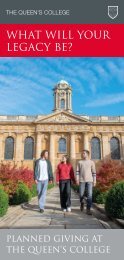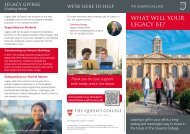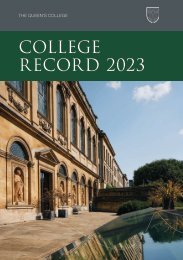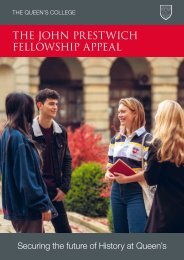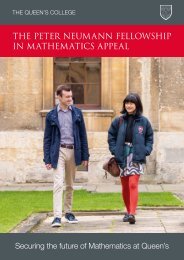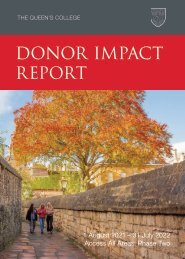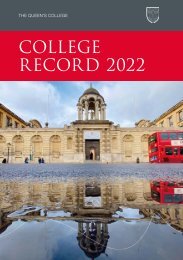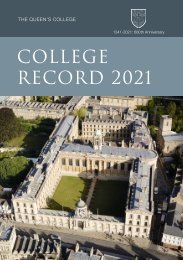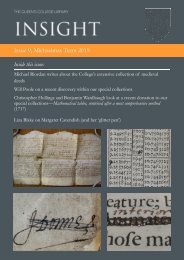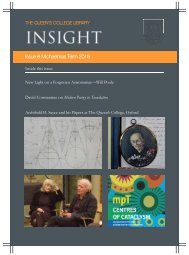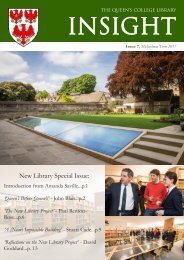The Queen's College Record 2020
Create successful ePaper yourself
Turn your PDF publications into a flip-book with our unique Google optimized e-Paper software.
team player, recognised for his humility and generosity. John served others even in his<br />
last breath as it was always his wish to donate his organs, an act that has undoubtedly<br />
transformed many lives.<br />
Obituaries<br />
John leaves Sarah and their three children: Thomas (8), Anna (7), and Matthew (5).<br />
His elder siblings, Peter and Helen, have lost a dear brother. Few of us, medics or not,<br />
could ever live up to his very high standards and kind work ethic. His motto – ‘Be kind<br />
to one another’ – will be remembered as we continue to treat patients in some very<br />
challenging times. We are all devastated at the loss of this gentle giant.<br />
D J Unsworth (originally published in BMJ 2019;367:l5869, and reprinted with their<br />
permission)<br />
MARTIN GREEN<br />
Dr Martin Green FRSC, who spent six years at Queen’s<br />
from 1973, reading Chemistry as an undergraduate,<br />
then staying on for his DPhil, died suddenly from a brain<br />
haemorrhage on 16 September 2019.<br />
He was born in Belfast in 1953, and lived there until<br />
his mid-teens, attending Royal Belfast Academical<br />
Institution, until his family moved to Lincolnshire at the<br />
onset of the Troubles.<br />
At Queen’s he was a notable sportsman, representing the <strong>College</strong> in rugby and rowing,<br />
with an enthusiasm that led one of his tutors to remind him that, ‘You’re here to read<br />
Chemistry, not Rowing.’ He obviously listened, progressing to do a doctorate, but still<br />
prone to distractions: he met Monika, another chemist who was to become his wife<br />
and companion for 40 years, as they both worked in the labs on South Parks Road.<br />
Martin was a rare one-company man, working at Unilever from his first job until his<br />
retirement in 2015 as Head of Human Biology in the Life Sciences Group. Being<br />
a research chemist was his forte, turning leading-edge science into products of<br />
practical value. He specialised in skin repair and rejuvenation treatments, reversing<br />
brittle bone disease, stimulating hair condition and growth, gum health, vascular<br />
health and wound healing.<br />
He was an early proponent of gene technology. A notable success was when he led<br />
the Unilever team which identified plant lipids that could activate a regulatory gene<br />
called PPAR that is present in skin cells and can slow down the ageing process. He<br />
and his research teams were granted an unusually large number of patents – more<br />
than 40.<br />
126 <strong>The</strong> Queen’s <strong>College</strong> | <strong>College</strong> <strong>Record</strong> <strong>2020</strong>






